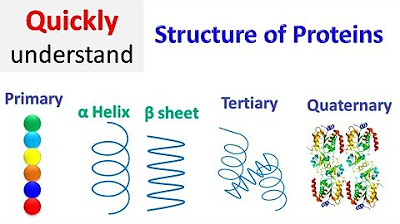Protein Structure (Primary, Secondary, Tertiary, and Quaternary) | Biochemistry
Summary
TLDRThis lecture by Medicosis provides an insightful exploration of protein structure, detailing the four essential levels: primary, secondary, tertiary, and quaternary. It emphasizes the significance of amino acid sequences in determining a protein's shape and function, explaining how various interactions, such as hydrogen bonds and hydrophobic interactions, contribute to its stability. The presentation highlights the importance of understanding these structures for exams like the MCAT and for grasping the biochemical foundations of life. With a blend of humor and clarity, Medicosis makes complex topics accessible and engaging for students and enthusiasts alike.
Takeaways
- 😀 The primary structure of proteins is the linear sequence of amino acids, crucial for determining protein function.
- 🔗 Peptide bonds form the backbone of the primary structure by linking amino acids together.
- 🌀 Secondary structures include alpha helices and beta-pleated sheets, stabilized by hydrogen bonds.
- ⚠️ Proline can disrupt secondary structures when placed in the middle of an alpha helix or beta sheet.
- 🌐 Tertiary structure represents the overall three-dimensional shape of a protein, critical for its functionality.
- 🔍 The tertiary structure is stabilized by various interactions, including hydrogen bonds, salt bridges, and disulfide bonds.
- 👥 Quaternary structure involves the assembly of multiple polypeptide chains, such as in hemoglobin and antibodies.
- 💧 Hydrophobic interactions play a vital role in stabilizing the tertiary structure by burying nonpolar side chains.
- 🔄 Salt bridges, formed between charged side chains, contribute to the stability of protein structures.
- 🔒 Disulfide bonds are strong covalent connections that reinforce protein structure, particularly in extracellular environments.
Q & A
What is the primary structure of a protein?
-The primary structure of a protein is the linear sequence of amino acids linked by peptide bonds, which determines the protein's overall structure and function.
What are the two main types of secondary structures in proteins?
-The two main types of secondary structures are alpha helices and beta-pleated sheets, both stabilized by hydrogen bonds between amino acids.
How is tertiary structure formed in proteins?
-Tertiary structure is the three-dimensional shape of a protein formed by interactions such as hydrogen bonds, disulfide bridges, and ionic bonds between R groups of amino acids.
What is quaternary structure, and why is it important?
-Quaternary structure refers to the arrangement of multiple polypeptide chains into a larger protein complex. It enhances protein stability and function, reduces genetic coding requirements, and increases catalytic efficiency.
What role do hydrogen bonds play in protein structure?
-Hydrogen bonds stabilize both secondary and tertiary structures of proteins by forming interactions between polar groups within the amino acids.
What happens during protein denaturation?
-During protein denaturation, the tertiary structure of a protein is disrupted, leading to the loss of its functional shape, often caused by environmental changes like temperature or pH.
Why is it important to understand the relationship between protein sequence and function?
-Understanding the relationship between protein sequence and function is crucial because even small changes in amino acid sequence can significantly affect a protein's structure and its biological activity.
What is the process of protein synthesis?
-Protein synthesis involves the translation of mRNA into a polypeptide chain at ribosomes, where amino acids are linked together in a specific order according to the mRNA sequence.
How can students effectively study biochemistry concepts?
-Students can enhance their understanding of biochemistry concepts by actively taking notes, starting with foundational biology knowledge, and reviewing complex topics systematically.
What are some examples of proteins with quaternary structure?
-Examples of proteins with quaternary structure include hemoglobin, which carries oxygen in the blood, and antibodies, which play a critical role in the immune response.
Outlines

This section is available to paid users only. Please upgrade to access this part.
Upgrade NowMindmap

This section is available to paid users only. Please upgrade to access this part.
Upgrade NowKeywords

This section is available to paid users only. Please upgrade to access this part.
Upgrade NowHighlights

This section is available to paid users only. Please upgrade to access this part.
Upgrade NowTranscripts

This section is available to paid users only. Please upgrade to access this part.
Upgrade NowBrowse More Related Video

The Central Dogma: DNA to proteins (an animated lecture video)

Protein structure | Primary | Secondary | Tertiary | Quaternary

Protein Structure - Primary, Secondary, Tertiary, & Quarternary - Biology

Levels of Protein Structure

Proteins: Primary and Secondary Structure | A-level Biology | OCR, AQA, Edexcel

Tertiary structure of proteins | Macromolecules | Biology | Khan Academy
5.0 / 5 (0 votes)